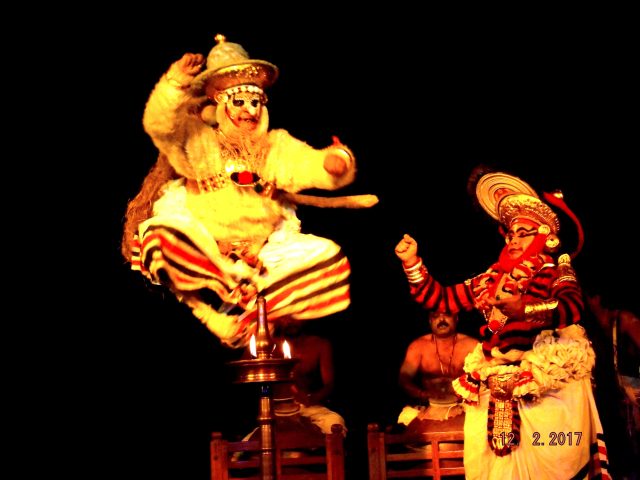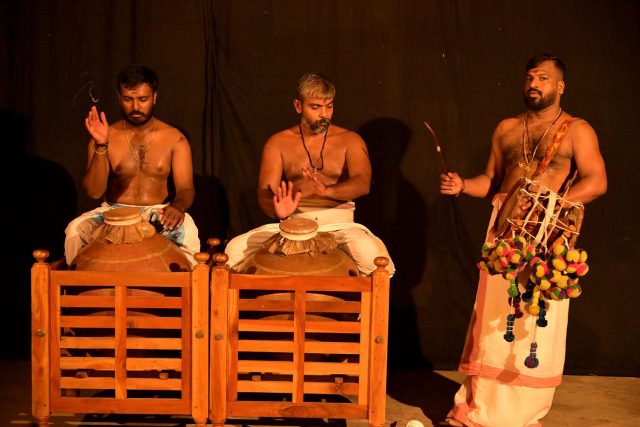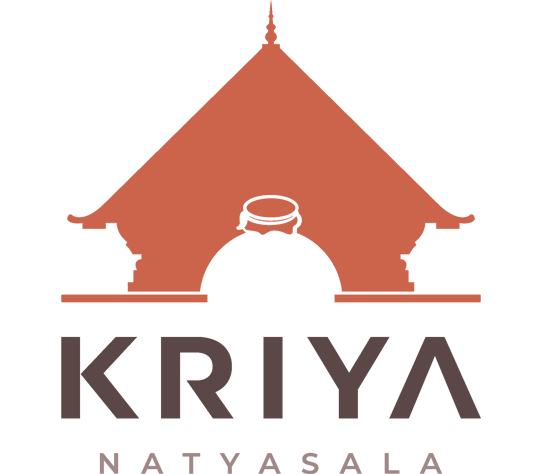KŪṬIYĀṬṬAṀ
Masterpiece of the Oral and Intangible Heritage of Humanity
KŪṬIYĀṬṬAṀ
KŪṬIYĀṬṬAṀ (Koodiyattam) is a form of Sanskrit theatre traditionally performed in the state of Kerala, India. It is officially recognized by UNESCO as a masterpiece of the Oral and Intangible Heritage of Humanity. Kutiyattam has won worldwide acclaim as a unique form of acting in its perfection. It is the only surviving relic of ancient Indian theatre, which has an uninterrupted history of more than 2000 years.
It draws on a rich corpus of Sanskrit plays which have come down to us from different historical periods from the 1st to 7th centuries AD. Here is an example of a mode of theatre that follows its own aesthetics and performance principles with a firm base on the spirit of a pan-Indian dramatic tradition, represented by the theories formulated in the Natya Sastra, the text on the science of dramaturgy dating roughly between 200 BC and 200 AD.
Kutiyattam is traditionally performed by a community of Chakyars, the male actors, and Nangiars, women performers, as a hereditary profession. The Chakyars were assisted by Nambyars who play the drum called Mizhavu in amphitheatres called kuthambalams.
The word Kutiyattam is derived from the prefix “koodi” in Malayalam, which stands for “combined” or “together,” and “attam,” which means “acting.” Simply put, it is a theatre in which several characters come together on the stage.
There is evidence throughout history that Sanskrit drama was a live mode of theatre in ancient times. Scholars have traced the origins of theatre in India to the distant past, from the dialogue hymns of the Rig Veda to Nata Sutras mentioned by Panini. Kutiyattam claims an antiquity of about 2000 years, but its origin and early days are shrouded in mystery. There are no clear pieces of evidence to reconstruct the history for the first thousand years, and therefore only conjectures are possible. By the end of the eighth century, there are descriptions of the stage enactment of Sanskrit plays available in various texts.

The adaptation of Sanskrit plays to the Kerala stage may have been initiated by aristocratic Brahmins equipped with Sanskrit learning, leisure, and refinement in taste. Well-versed in aesthetics, dramaturgy, and dramatic literature, they played a critical role in the choreography of kutiyattam in its early days.
As an art form, it was codified and refined during the time of Kulashekhara, the ruler of Kerala from 978 CE to 1076 CE. The functional status of an actor according to Natyasastra is that of an imitator. Kulashekhara endowed two more functions with him: that of a narrator and an interpreter. This gave the Kutiyattam actor a lot of opportunities for imaginative acting.
Realizing the danger of kutiyattam to exclusive, erudite taste, the choreographers introduced and developed the role of Vidushaka or jester and made him a popular comic character on the stage. In Kutiyattam, the Vidushaka has a place as important as that of the hero. Unlike the hero and other characters, however, the Vidushaka has the right to verbal speech. Apart from enacting his own role, he has to repeat the words of other characters and humorously interpret them to please the audience.

A striking feature of Kutiyattam is that it bases its performance not on the full text of a Sanskrit play but on the individual acts. The play in Kutiyattam provides only the bare minimum text for the actor to elaborate into multiple meanings and imaginative improvisation. The text is only pretext, and the production
of the play depends on subtexts provided by the stage manual. Situations of poetic richness and dramatic potential are elaborated in Kutiyattam to unravel the layers of meaning embedded in the text of the play. The acting is so slow and elaborate that a play can stretch up to 40 nights or more to complete the action.
Kutiyattam makes use of a stylized highly evolved mime language that emphasizes facial expressions and hand gestures. The stylized acting through ‘Netrabhinaya’ or the manipulation of the eye is of vital importance. The movement of eyes and power of expression are so refined, pervasive, and wide-ranging that they can portray any situation, activity, thought, or feeling.
Considered a complex, inflexible, and ancient art form requiring considerable patience and time for a fire understanding, Kutiyattam has a way of growing on you. It is addictive enough to never let you out of its spell for life.
Origin and Evolution
Koodiyattam, meaning “combined acting” in Malayalam, merges the grandeur of Sanskrit theatre with the artistry of Koothu. Performed in temple theatres known as koothambalams, it is the only surviving art form that preserves ancient Sanskrit drama traditions. With a history spanning over a thousand years, its precise origins remain unclear.
Both Koodiyattam and Chakyar Koothu trace their roots to the ancient performing art Koothu, referenced in Sangam literature and inscriptions from the Pallava, Pandiyan, Chera, and Chola periods. Temples across South India, such as those in Tanjore, Tiruvidaimaruthur, and Tiruvarur, house inscriptions linking Koothu to sacred worship practices. Notably, rulers from these eras contributed plays to these traditions, including the Pallava king Rajasimha, who authored Kailasodharanam, depicting Ravana’s encounter with Shiva.
During the medieval period, Kulasekhara Varma of the Chera Perumal dynasty reformed Koodiyattam. He introduced the use of Malayalam for the Vidushaka (comic character) and structured performances into defined segments. His plays Subhadradhananjayam and Tapatisamvarana are still performed today, alongside works like Ascaryacudamani by Saktibhadra and Kalyanasaugandhika by Nilakantha.
Instruments and Music

The musical accompaniment in Koodiyattam is integral to its storytelling. Key instruments include:
- Mizhavu: A large percussion instrument, traditionally played by members of the Ambalavas Nambiar caste.
- Kuzhitalam: Cymbals played by Nangyaramma.
- Edakka, Kurumkuzhal, and Sankhu: Supporting instruments enriching the performance.
Performance Style
Traditionally, Koodiyattam was performed by Chakyars and Nangyaramma in temples. The term “Koodiyattam” likely refers to the collaboration of multiple actors on stage or the practice of joining solo performers in Sanskrit drama. Female roles are portrayed by Nangyaramma, as Illotammas (Chakyar women) do not participate.
Performances, ranging from 12 to 150 hours over multiple nights, are divided into three parts:
- Purappadu: The introduction, where an actor performs a verse with accompanying dance.
- Nirvahanam: A retrospective using abhinaya (expressive gestures) to depict the main character’s backstory.
- Koodiyattam: The main play, featuring multiple characters.

